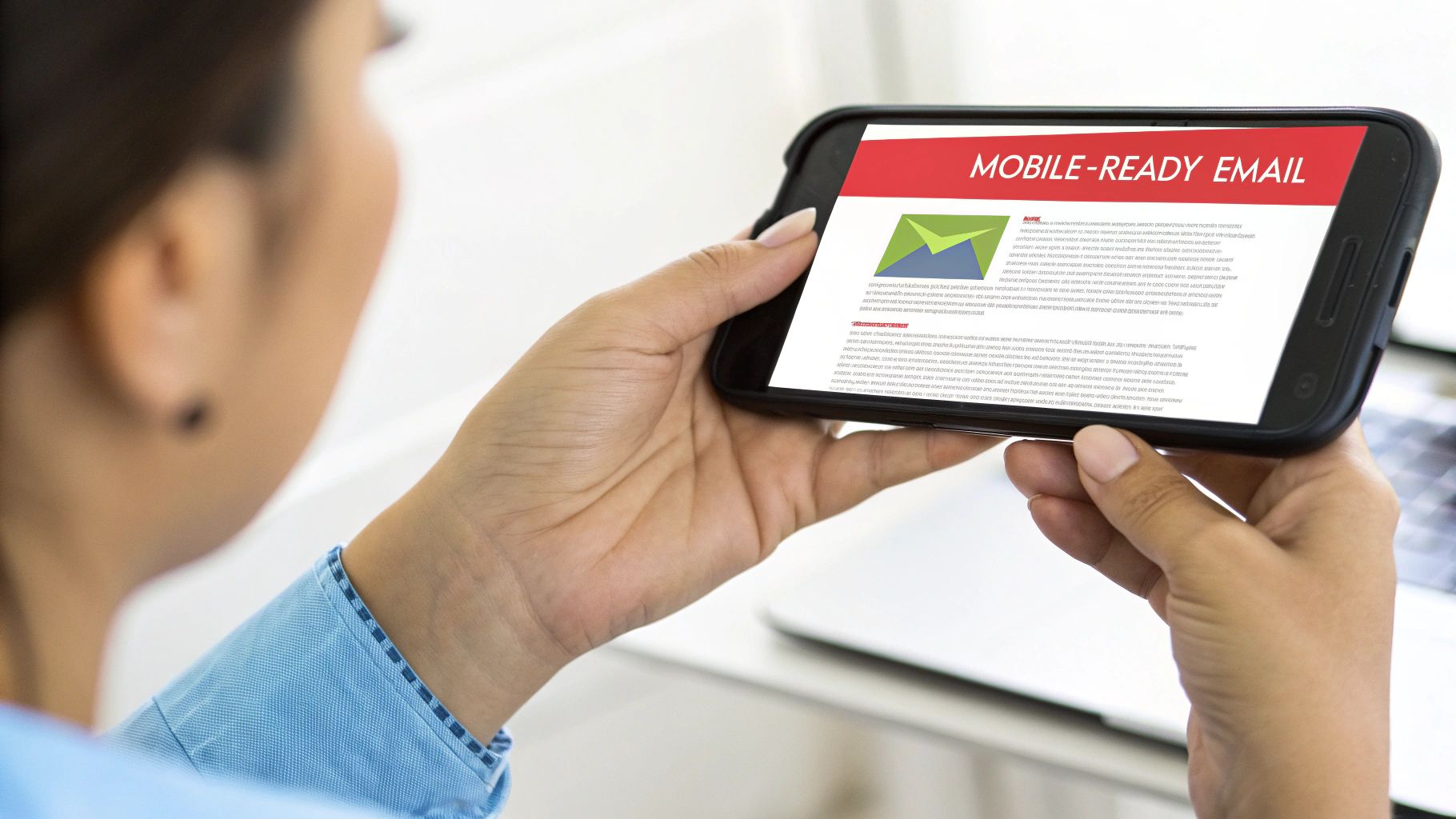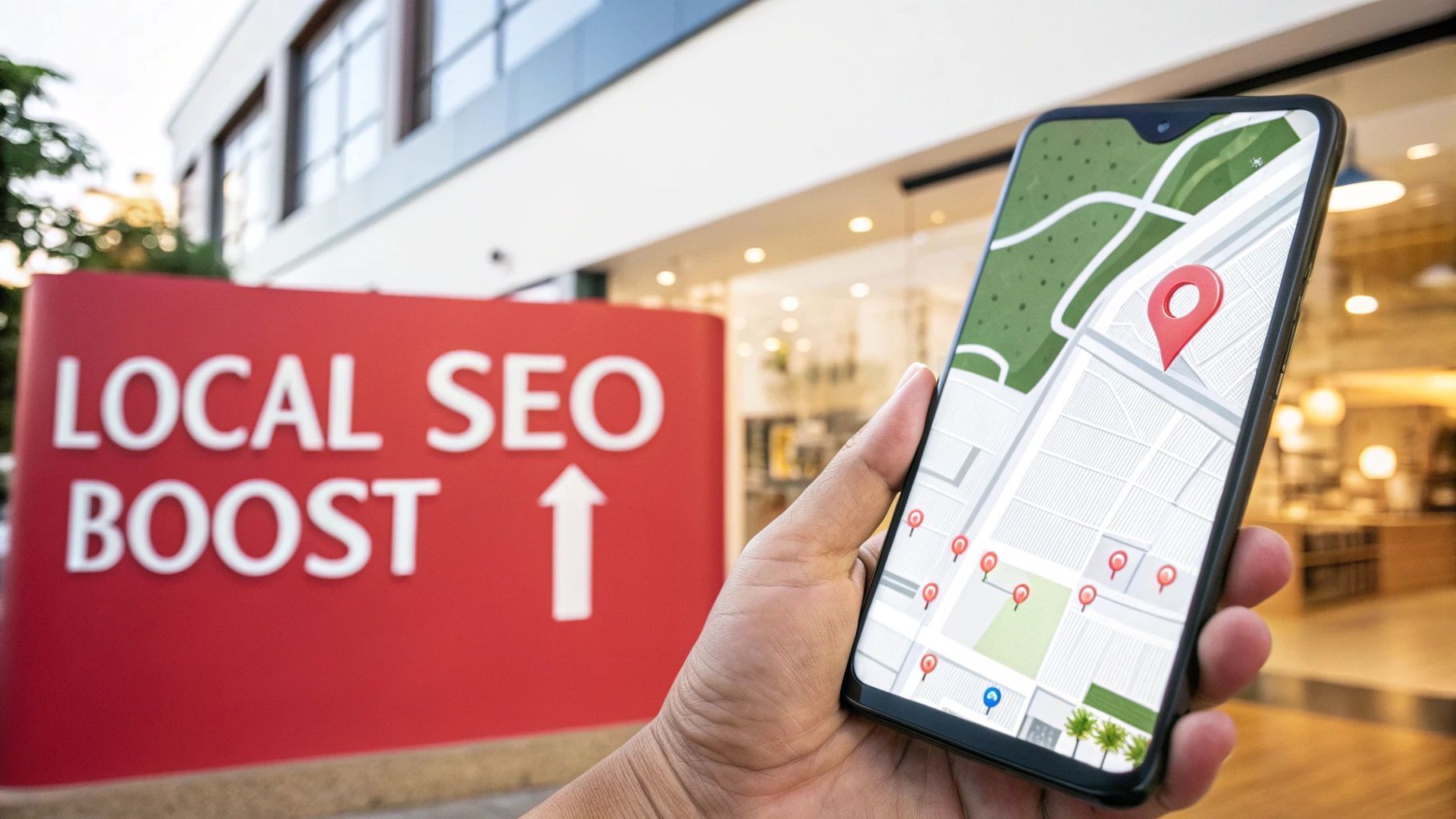9 Email Marketing Best Practices for 2025 Success
In the crowded digital marketplace, simply sending an email is no longer enough. To capture attention, build relationships, and drive meaningful results, a strategic approach is essential. The difference between an email that gets deleted and one that converts lies in the application of proven, modern techniques that respect your audience's time and intelligence. This guide moves beyond generic advice to provide a definitive roundup of essential email marketing best practices .
We will explore nine critical pillars, from the technical foundations of deliverability to the creative nuances of personalisation, equipping you with the actionable insights needed to refine your strategy. Mastering these elements is fundamental for any brand looking to maximise its return on investment. Whether you're aiming to enhance engagement, boost conversions, or build lasting customer loyalty, these practices form the blueprint for a successful email programme. For a comprehensive approach to leveraging email for business growth, explore detailed strategies to get more customers with email marketing. This article will delve into the specific, practical steps you can implement today to transform your inbox presence from background noise into a powerful communication channel.
1. Personalisation and Segmentation
Moving beyond the generic "Dear [First Name]" is no longer optional; it's a fundamental component of effective email marketing best practices. Personalisation involves tailoring email content to individual recipients using their data, such as preferences, behaviour, and demographics. Segmentation is the process of dividing your email list into smaller, more manageable groups based on shared characteristics. This dual approach ensures your message is not just seen, but felt.
When you send highly targeted content, it resonates on a personal level. Think of Amazon's product recommendations based on your browsing history or Spotify's curated playlist emails reflecting your listening habits. These companies don't just send emails; they deliver tailored experiences. This level of relevance is what transforms a passive subscriber into an engaged customer, dramatically boosting open rates, click-throughs, and ultimately, conversions.
How to Implement Personalisation and Segmentation
Getting started doesn't have to be complex. You can begin by implementing a few core strategies and build from there:
- Start with Basic Segments: Begin by grouping your audience by demographics (age, location) or past purchase history. Even this simple step is more effective than a one-size-fits-all approach.
- Use Dynamic Content: Create a single email template where specific blocks of content change based on the recipient's segment. A clothing retailer could show different hero images for menswear and womenswear within the same campaign.
- Implement a Preference Centre: Allow subscribers to self-segment by telling you exactly what they want to receive, from content types to frequency. This not only improves targeting but also respects their inbox.
The infographic below highlights just how powerful this strategy is, showcasing the significant uplift in key engagement metrics.
As the data clearly shows, segmented campaigns don't just perform better, they generate substantially higher click-through rates and account for the majority of email revenue. This underscores the direct link between relevance and results. For a deeper dive into crafting these strategies, you can discover more about the power of personalisation in email marketing.
2. Mobile Optimisation and Responsive Design
With a majority of emails now first opened on a mobile device, optimising for smaller screens is a non-negotiable email marketing best practice. Mobile optimisation ensures your emails display correctly and function seamlessly on smartphones and tablets. Responsive design is the technique that allows an email’s layout, images, and text to automatically adjust to fit any screen size, providing an ideal viewing experience for every user.

Failing to optimise for mobile creates a jarring experience, leading to immediate deletion and potential unsubscribes. In contrast, a well-designed mobile email feels intuitive and professional. Think of Uber's simple, mobile-first receipts with large, tappable buttons, or Starbucks' promotional emails with easily scannable reward codes. These brands prioritise the on-the-go user, ensuring their message is not only delivered but also easily actioned, which is crucial for driving engagement and conversions.
How to Implement Mobile Optimisation
Ensuring your emails are mobile-friendly involves a combination of design principles and technical checks. You can start by integrating these core strategies into your workflow:
- Adopt a Single Column Layout: This is the safest and most effective structure for mobile viewing, as it prevents awkward horizontal scrolling and keeps your content neatly stacked.
- Make CTAs Tappable: Design your call-to-action buttons to be at least 44x44 pixels. This size is large enough for comfortable tapping with a thumb and should be surrounded by white space to avoid accidental clicks.
- Keep Subject Lines Concise: Aim for subject lines under 50 characters to ensure they are fully visible on most mobile notification screens, grabbing attention without being cut off.
- Test on Real Devices: While emulators are useful, they don’t always capture the nuances of how different mobile clients render emails. Test your campaigns on both iOS and Android devices to guarantee a consistent, high-quality experience for all subscribers.
3. Compelling Subject Lines and Preheader Text
Your subject line is the digital handshake of your email; it's the first impression and the single most critical factor determining whether a subscriber opens your message or sends it straight to the bin. Paired with the preheader text, that snippet of copy visible after the subject line, it forms a powerful duo to capture attention, communicate value, and entice a click. This is a cornerstone of email marketing best practices where clarity, curiosity, and relevance must converge.
An exceptional subject line does more than just describe the email's contents; it sparks an emotional response or creates intrigue. Think of Grammarly's personalised "Your writing made a strong impression in 2023" or Casper's curiosity-driven "You looked at these. Now look again." for an abandoned cart. These examples demonstrate how a well-crafted entry point can feel personal and compelling, significantly boosting open rates and setting the stage for engagement before the email is even opened.
How to Implement Compelling Subject Lines and Preheader Text
Mastering this art requires a mix of creativity, psychology, and data-driven testing. You can begin by implementing these core strategies to make your emails stand out in a crowded inbox:
- A/B Test Everything: Don’t guess what works. Test different subject line approaches on a portion of your list (e.g., 20%) and send the winning version to the rest. Test questions vs. statements, length, and the use of emojis.
- Create Urgency and Scarcity Authentically: Phrases like "Sale ends tonight" or "Limited stock remaining" can be powerful motivators, but only when they are genuine. False urgency erodes trust and can harm your sender's reputation.
- Use Power Words and Numbers: Integrate words like 'exclusive', 'proven', or 'discover' to add impact. Numbers and lists, such as "5 Ways to Improve Your Workflow," provide clear structure and promise tangible value.
- Optimise Preheader Text: Don't let your preheader default to "View this email in your browser." Use this valuable space to supplement your subject line with a compelling call to action or additional context that encourages opens.
4. Clear Call-to-Action (CTA) Strategy
Every email needs a purpose, and a clear call-to-action (CTA) is the signpost that guides your subscribers toward that goal. A CTA directs recipients to the specific action you want them to take, whether it's making a purchase, downloading content, or registering for an event. An effective CTA strategy is a cornerstone of email marketing best practices, as it eliminates confusion and provides a clear, frictionless path for the user to follow.
The goal is to move beyond a simple hyperlink and create a compelling, visually distinct instruction. Think of Airbnb's "Continue Booking" button, which maintains momentum in the user journey, or Dropbox's inviting "Get started for free," which removes commitment pressure. These CTAs are successful because they are singular in focus, action-oriented, and perfectly aligned with the email's message, transforming passive readership into active engagement and conversion.

How to Implement a Clear CTA Strategy
Building an effective CTA involves a combination of design, psychology, and strategic placement. Start by integrating these core principles into your email templates:
- Use Strong, Action-Oriented Language: Swap generic words like "Submit" for more specific and compelling verbs. Test different options like "Get Your Guide," "Claim My Discount," or "Discover the Collection" to see what resonates with your audience.
- Create Visual Prominence: Your primary CTA should stand out. Use a contrasting colour for the button so it doesn't blend into the background, and ensure it's large enough to be easily tappable on mobile devices. Data shows button CTAs outperform text links significantly.
- Maintain a Singular Focus: While a secondary, less prominent CTA can be useful, your main email should guide users toward one primary action. Placing this main CTA "above the fold" ensures it's visible without scrolling, capturing attention immediately.
- Ensure Landing Page Congruency: The journey shouldn't end at the click. The landing page your CTA directs to must directly continue the promise made in the email. If the CTA is "Shop the Sale," the link must lead directly to the sale page, not the homepage.
5. Permission-Based List Building and Double Opt-In
The foundation of all successful email marketing best practices is consent. Permission-based marketing, popularised by Seth Godin, means only communicating with people who have explicitly agreed to hear from you. The double opt-in process strengthens this foundation by requiring subscribers to confirm their email address via a verification link sent to their inbox after they first sign up. This two-step process is crucial for building a high-quality, engaged email list.
This approach ensures you are communicating with people who genuinely want your content, which drastically reduces spam complaints and improves deliverability. Think of The New York Times' newsletter signup, which clearly sets expectations about content and frequency, followed by a simple confirmation email. This not only complies with regulations like GDPR but also starts the relationship on a footing of trust and respect, leading to higher long-term engagement and a healthier sender reputation.
How to Implement Permission-Based List Building
Building a quality list from the ground up is more valuable than having a large, unengaged one. Here are some strategies to implement this effectively:
- Set Clear Expectations: On your signup form, be transparent about what subscribers will receive and how often. HubSpot’s preference centre is a great example, allowing users to choose the specific topics they are interested in.
- Design a Compelling Confirmation Email: Don't use a generic template. Infuse your brand's voice and personality into the confirmation email, like the witty copy often seen in Morning Brew’s process. Make the confirmation button prominent and easy to click.
- Deliver Value Immediately: Send the confirmation email instantly while the subscriber's interest is at its peak. Once they confirm, trigger a welcome email or series that provides immediate value, reinforcing their decision to join your list.
6. Email List Hygiene and Regular Maintenance
Focusing on list quality over sheer quantity is one of the most impactful email marketing best practices you can adopt. List hygiene involves regularly cleaning your database by removing invalid email addresses, inactive subscribers, and disengaged contacts. This essential maintenance is not about shrinking your audience; it's about refining it to ensure your messages reach people who genuinely want to hear from you.
A clean, engaged list directly translates into higher deliverability, improved open and click-through rates, reduced marketing costs, and a protected sender reputation. Internet Service Providers (ISPs) like Gmail and Outlook penalise senders with high bounce rates and low engagement, pushing their emails to the spam folder. Think of BuzzFeed's aggressive list cleaning, which improved its overall engagement by 25%, or Travelocity's quarterly protocol that cut costs by 30%. These examples prove that a smaller, more active list is far more valuable than a large, dormant one.
How to Implement Email List Hygiene
Integrating regular maintenance into your workflow is crucial for long-term email marketing success. Here are some actionable steps to get started:
- Remove Hard Bounces Immediately: A hard bounce signifies a permanent delivery failure (e.g., an invalid address). These should be removed automatically by your email service provider after every campaign to protect your sender score.
- Implement Re-engagement Campaigns: Target subscribers who haven't opened an email in 90-180 days with a "win back" campaign. Offer an incentive or ask if they still wish to subscribe. If they don't re-engage, it's time to let them go.
- Create a Sunset Policy: Establish a clear process for removing chronically inactive subscribers. Send a final "goodbye" email explaining they will be removed unless they take action, giving them one last chance to stay.
- Use Email Verification Services: Employ tools like NeverBounce or ZeroBounce at the point of signup to prevent invalid or typo-ridden email addresses from ever entering your list.
Just as your website requires regular upkeep to perform optimally, your email list needs consistent attention to deliver results. This process of cleansing and optimisation is a core part of a healthy digital strategy. For more insights on maintaining your digital assets, you can explore the principles behind professional website maintenance services.
7. A/B Testing and Data-Driven Optimisation
Relying on guesswork is one of the quickest ways to stunt campaign growth. A/B testing, also known as split testing, is a core email marketing best practice that replaces assumptions with data. It involves sending two or more variations of an email to different segments of your audience to see which one performs better against a specific goal. This scientific approach enables continuous, incremental improvements that compound over time.
This method allows you to validate your hypotheses with real user behaviour. For instance, the Obama 2012 campaign famously used rigorous A/B testing on everything from subject lines to donation buttons, ultimately raising hundreds of millions more in donations. Similarly, Groupon constantly tests its subject lines to maximise engagement. This data-driven process is what separates high-performing email programmes from those that remain static.
How to Implement A/B Testing and Data-Driven Optimisation
Integrating testing into your workflow is straightforward and highly impactful. Start with controlled experiments to build a foundation of knowledge:
- Test One Element at a Time: To know what truly caused a change, isolate a single variable per test, whether it’s the call-to-action (CTA) button colour, the subject line, or the send time.
- Prioritise High Impact Tests: Begin by testing elements that have the largest potential effect on your key metrics. Subject lines, CTAs, and email copy are excellent starting points before moving to smaller details.
- Ensure Statistical Significance: Use a large enough sample size for your test to be valid. Aim for a statistical confidence level of at least 95% before declaring a winner and rolling it out to the rest of your list.
- Document and Learn: Keep a detailed log of all tests, including your hypothesis, the variations, the results, and your conclusions. This creates a valuable internal resource that informs future campaigns.
By systematically testing and learning, you can refine your strategy based on what your audience actually responds to, not just what you think they will. This is a cornerstone of effective digital marketing. For a broader look at this approach, you can learn more about harnessing data-driven marketing strategies for success.
8. Value-First Content and Appropriate Send Frequency
Shifting from a purely promotional mindset to a value-first approach is one of the most critical email marketing best practices for building long-term trust. This strategy prioritises delivering genuine value with every email, focusing on education, entertainment, or problem-solving. It's about earning attention, not just demanding it. Coupled with an appropriate send frequency, this method respects the subscriber's inbox and transforms your brand from a seller into a welcome resource.
Think of newsletters like Ann Handley's Total Annarchy or Morning Brew. They don't just sell; they deliver insightful marketing commentary or curated business news that subscribers genuinely look forward to. This approach, popularised by concepts like Gary Vaynerchuk's "Jab, Jab, Jab, Right Hook," builds a relationship where promotional content, when it does appear, is received much more openly. It’s a powerful way to reduce unsubscribe rates and cultivate a loyal, engaged audience.
How to Implement a Value-First Strategy
Finding the right balance between value and promotion requires a thoughtful content plan and a commitment to listening to your audience. Here are some actionable steps to get started:
- Follow the 80/20 Rule: A great starting point is to ensure that 80% of your content provides direct value (how-to guides, industry news, personal stories) while only 20% is directly promotional.
- Establish a Content Calendar: Plan your emails in advance to ensure a consistent delivery of high-value content. This prevents you from defaulting to last-minute promotional sends when you're out of ideas.
- Use a Preference Centre: Empower your subscribers by letting them choose their preferred send frequency (e.g., daily, weekly, monthly). This simple act of giving control can significantly improve retention.
- Monitor Engagement Signals: Pay close attention to your metrics. A sudden spike in unsubscribes after a send is a clear indicator that your frequency might be too high or the content didn't resonate as expected. Adjust accordingly.
9. Deliverability Best Practices and Technical Setup
Even the most brilliantly crafted email is useless if it never reaches the inbox. Email deliverability is the technical foundation of your entire strategy, determining whether your messages land in the primary inbox, get filtered to spam, or are blocked entirely. This is a crucial aspect of email marketing best practices, involving authentication, reputation management, and adherence to internet service provider (ISP) guidelines.
Strong deliverability is non-negotiable. Without it, your investment in content, design, and personalisation is wasted. Think of major brands like PayPal, whose strict DMARC authentication policies prevent phishing emails and protect their domain’s reputation. Similarly, email service providers like Mailchimp meticulously manage the reputation of their shared IP pools to ensure high delivery rates for their small business clients. Getting this technical setup right is the first step towards a successful campaign.
How to Implement Deliverability Best Practices
Protecting your sender reputation and ensuring inbox placement requires a proactive, technical approach. You can begin by implementing these essential strategies:
- Establish Authentication Protocols: Before sending any campaigns, set up your SPF, DKIM, and DMARC records in your DNS settings. These protocols act like a digital passport, proving to receiving servers that your emails are legitimate and not forged.
- Warm Up Your IP Address: If you are using a new dedicated IP address, you must warm it up. Start by sending a small volume of emails (e.g., 50-100) to your most engaged subscribers and gradually increase the volume daily over several weeks.
- Monitor Your Sender Reputation: Regularly check your sender score using tools like Validity's Sender Score or Google Postmaster Tools. This allows you to monitor how ISPs view your domain and IP, helping you catch potential issues before they escalate. Keep your spam complaint rate below 0.1% and bounce rates below 5%.
Email Marketing Best Practices Comparison
| Strategy | Implementation Complexity 🔄 | Resource Requirements ⚡ | Expected Outcomes 📊 | Ideal Use Cases 💡 | Key Advantages ⭐ |
|---|---|---|---|---|---|
| Personalisation and Segmentation | Medium to High 🔄🔄 | High ⚡⚡ | Higher engagement, 14.31% more opens, 100.95% more clicks 📊 | Targeted campaigns requiring precise audience tailoring | Increased revenue (58%), improved loyalty |
| Mobile Optimisation and Responsive Design | Medium 🔄 | Medium ⚡ | Improved mobile UX, +15% CTR, reduced deletions 📊 | Emails with large mobile audience | Enhanced brand perception, better mobile reach |
| Compelling Subject Lines and Preheader Text | Low to Medium 🔄 | Low ⚡ | Increased open rates, up to +50% with personalisation 📊 | All campaigns needing strong open rates | Easy testing, strong direct impact on opens |
| Clear Call-to-Action (CTA) Strategy | Low to Medium 🔄 | Low to Medium ⚡ | +371% clicks, +1617% sales (single CTA) 📊 | Conversion-focused emails | Increased conversions, reduced decision fatigue |
| Permission-Based List Building and Double Opt-In | Medium 🔄🔄 | Medium ⚡ | 2x higher engagement, 90% less spam complaints 📊 | Compliance-focused and quality list building | Legal compliance, higher deliverability, engaged base |
| Email List Hygiene and Regular Maintenance | Medium 🔄 | Medium ⚡ | +5-10% deliverability, +25-50% engagement 📊 | Long-term list health & cost reduction | Improved sender reputation, lower costs |
| A/B Testing and Data-Driven Optimisation | Medium to High 🔄🔄 | Medium ⚡ | Average 28% ROI uplift, 50%+ conversion increase 📊 | Data-driven optimisation and continuous improvement | Removes guesswork, boosts campaign performance |
| Value-First Content and Appropriate Send Frequency | Medium 🔄 | Medium to High ⚡ | Lower unsubscribes, 3x more engagement on value content 📊 | Relationship-building and long-term engagement | Builds trust, reduces fatigue |
| Deliverability Best Practices and Technical Setup | High 🔄🔄🔄 | High ⚡⚡ | Inbox placement improved by 10-15%, avoids 21% spam 📊 | Ensuring email reaches inbox consistently | Protects reputation, maximises delivery |
Putting It All Together: Your Path to Email Excellence
Mastering the art and science of email marketing is not a one-time project; it is an ongoing journey of refinement, learning, and adaptation. We have explored nine foundational pillars that are crucial for success. From the technical intricacies of deliverability and list hygiene to the creative craft of compelling subject lines and value-first content, each practice plays a vital role in building a robust and effective email programme.
The central theme connecting all these elements is a shift in perspective. Instead of viewing email as a simple broadcast tool for your messages, successful marketers see it as a direct, personal line of communication with their audience. This subscriber-centric mindset is the key to unlocking true engagement. It means earning permission, respecting the inbox, and consistently delivering value long before you ask for a sale. Adopting these email marketing best practices is about building relationships, not just sending campaigns.
From Theory to Action: Your Next Steps
The sheer volume of advice can feel overwhelming, but progress is made through incremental, focused action. Rather than attempting to overhaul your entire strategy overnight, concentrate on one or two key areas that offer the greatest potential for improvement.
To put these insights into practice, consider the following steps:
- Conduct a Quick Audit: Review your last three email campaigns. Where are the obvious gaps? Are your subject lines optimised? Is your primary call-to-action clear and singular? A simple self-assessment will reveal your immediate priorities.
- Choose One Technical and One Creative Task: Pair a behind-the-scenes improvement with a content-focused one. For example, you might decide to implement a double opt-in process for all new subscribers (technical) while also committing to A/B testing your subject lines for the next month (creative).
- Measure and Document Everything: The only way to know if your changes are working is to track the right metrics. Monitor your open rates, click-through rates, and unsubscribe rates before and after implementing a new practice. This data will guide your future optimisations and prove the value of your efforts.
By embracing this methodical approach, you transform abstract knowledge into tangible results. Each small victory, whether it is a 1% increase in click-through rate or a reduction in your spam complaint rate, contributes to a more powerful, profitable, and respected email marketing channel. The journey to excellence begins with a single, well-informed step. Start today, and build an email programme that not only drives revenue but also turns subscribers into loyal brand advocates.
Ready to transform your email strategy from good to exceptional? The team at Superhub specialises in implementing these advanced email marketing best practices for businesses across the UK. Let us help you build a high-performing email programme that drives real growth by visiting us at Superhub to learn more.





